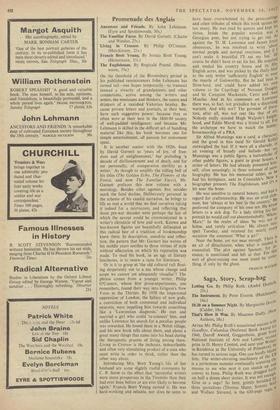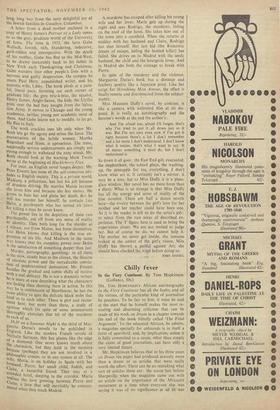Saga, Story, Scrap-bag
AFTER Mr. Philip Roth's sensational success with r Goodbye, Columbus (National Book Award ,„ 1960, Daroff Award, Guggenheim, grant frcl National Institute of Arts and Letters, seco0.. prize in 0. Henry Contest, and next year writer; in-Residence at the University of Princeton), he has turned to serious saga. One can hardly h13111)5 is
h im. The writer-elevating a portentous monster continually
scanning '4 machine of the the masses to see who next it can snatch uP a'th convey to fame. Philip Roth was dragged f°1rh. on half a dozen short stories. It was not enougy Give us a saga! So here, grimly heraldedi, b three quotations (Thomas Mann, Simone vw ea and Wallace Stevens), is the 630-page saga'
long, long way from the zany delightful joy of the Jewish families in Goodbye, Columbus. A letter from a dead mother enclosed in a Copy of Henry James's Portrait of a Lady opens to us the grey, graduate world of the University of Iowa. The time is 1953, the hero Gabe Wallach, Jewish, rich, blundering, indecisive, guilt-ridden and introspective. With the death of his mother, Gabe has fled to the Mid-West, to be drawn inexorably back to his father in New York each Thanksgiving and Christmas. Gabe wanders into other people's lives with a nervous and guilty desperation. On campus he meets Paul Herz, unpublished writer, and his neurotic wife, Libby. The book plods at a pain- ful, literal pace, ferreting out each corner of graduate life: the grey bric-h-brac, the squalor, Henry James, Anglo-Saxon, the kids, the Utrillo print over the bed they bought from the Salva- tiOn Army. It moves to Chicago and the young academics, neither young nor academic most of them. And Gabe learns not to meddle, to let go. He flies to Italy. The work crackles into life only when Mr. Roth lets go the agony and seizes the farce. The conversation of the brittle women, Martha Regenhart and Sissie, is uproarious. The tense, supposedly serious undercurrents are simply not strong enough to withstand the zany streak. Mr. Roth should look at the warning Mark Twain wrote at the beginning of Huckleberry Finn. For once, an English novel lunges deeper. Mr. Peter Everett has none of the self-conscious atti- tudes to English society. This is a private world. Madison, a policeman, has lost his job because of drunken driving. He marries Maisie because she loves him and because she has money. He grows to hate her and plans her death. But he Will not murder her himself; he contacts Leo Helm, a psychopath who has served six years for killing a man he never knew. The power lies in the depiction of these two PsYchopaths, cut off from any sense of reality or identity. They both long for the murder as a release, not from Maisie, but from themselves. Leo Helm knows that killing is the true ex- pression of his life. And Madison in the same
Way knows that his complete power over Helm is the satisfaction of something deeper than lust.
Murder, pornography, gambling: in all there is the slow, steady beat to the climax, the illusion of absolute power and the ineradicable convic- tion of predetermined damnation. Mr. Everett handles the gradual and subtle shifts of motive With a real delicacy. He is not a dramatic writer; he is more at ease describing what the characters are feeling than showing them in action. In this
Way he is reminiscent of Hawthorne; he has the same ability to spin the delicate black webs that
bind'us to each other. There is plot and excite- ment here, but more than these, a study of egotism which (in spite of some amateurism) thoroughly exorcises that bit of the murderer in each of us. 10.30 on a Summer Night is the third of Mar- guerite Duras's novels to be published in _England. Like the modern French novels of Nathalie Sarraute, this has planes like the edge of a diamond. One never knows much about because characters, but they hold in the memory because (perhaps) they are not involved in a Philosophic system, or in any system at all. The
husbandClaire, Pierre, her small child, Judith, and `lair; a beautiful friend. They stay at a crowded hotel, sleeping in the corridor. Maria realises the love growing between Pierre and Claire, a love that will inevitably be consum- mated when they reach Madrid.
A murderer has escaped after killing his young wife and her lover. Maria gets up during the night and sees Rodrigo, the murderer, hiding on the roof of the hotel. She takes him out of the town into a cornfield. When she returns at midday with her husband and Claire, Rodrigo has shot himself. Her last bid (the Romantic dream of escape, hiding the hunted killer) has failed. She drives on to Madrid with the seedy husband, the child and the bourgeois lover. And in Madrid she finds the courage to break with Pierre.
In spite of the murderer and the violence, Marguerite Duras's book has a distance and feathery quality like a Japanese print. Like her script for Hiroshima Mon Amour, the effect is finally remote and disconnected from the subject-
matter. )
Miss Maureen Duffy's novel, by contrast, is like a camera with unlimited film at its dis- pogal. It is really an autobiography and the heroine's words at the end the author's:
And I'm afraid too, afraid I'll forget, that's why I've tried to put it all down just as it was. But I'm not sure even now if I've got it right because there's a lot I don't remember and a lot more I don't understand. I don't know what it means, that's what .1 want to say. It all means something, it must do, but I don't understand it So down it all goes: the East End girl, evacuated, the stepbrothers, the school plays, the washing- up, the pineapple for tea, everything. I don't know what art is. It certainly isn't a mirror; it may be a Iens; but to Miss Duffy it is a plate- glass window. Her novel has no more form than a diary. What is so strange is that Miss Duffy has all the energy and sense of reality of the true novelist. There are half a dozen novels here—the rivalry between the girl's love for her mother and her teacher could have been one. As it is the reader is left to do the artist's job: to select from the vast areas of described ex- perience. The T figure here is used to bring the experiences closer. We are not invited to judge her. But of course we do, we cannot help it. The mother we never get inside; she remains locked in the amber of the girl's vision. Miss Duffy has thrown a pailful against Art; she should have checked:the wirld before doing so.
JOHN DANIEL







































 Previous page
Previous page